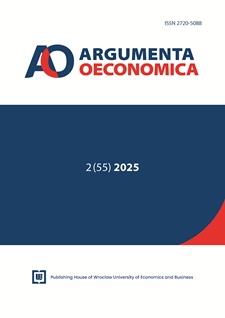Examining the J-curve and S-curve patterns in Pakistan’s economic ties with the USA and China; the world’s economic giants
DOI:
https://doi.org/10.15611/aoe.2025.2.15Keywords:
the USA, S-curve, J-curve, China, currency depreciation, 3-digit industries, PakistanAbstract
Aim: Since the Jand S-curve concepts were first introduced, several researchers have tried to test their validity through empirical research. To offer recommendations for additional research, this study looked at the relevant literature.
Methodology: The idea of the S-curve is an extension of the J-curve, which shows how the trade balance improves over time despite initially being worse due to currency depreciation. According to the S-curve hypothesis, there is a positive cross-correlation between the current exchange rate and the future trade balance of a country, and a negative cross-correlation between the current exchange rate and the past trade balance. To understand the pattern of the relationships, the author considered time series data for fifteen 3-digit industries/commodities between Pakistan and its main trading partners – China and the USA – from 1980 to 2022.
Results: The results demonstrate that the minority of Pakistani industries, engaged in trade with the USA and China, supported J and S-curves behaviour.
Implications and recommendations: The study showed that improving the trade balance is not always possible with domestic currency devaluation.
Originality/Value: This study made an incremental contribution in that it critiqued a consumer price index (CPI) which has been used in literature on the aggregate level, and constructed commodity-based CPI for the analysis.
Downloads
References
Aftab, Z., & Khan, S. (2008). Bilateral J-curves between Pakistan and her trading partners. The Pakistan Development Review, 47(1), 22-23. Retrieved from https://www.researchgate.net/publication/24111316_Bilateral_J-Curves_between_Pakistan_and_Her_Trading_Partners
Ahmad, S., Iqbal, J., Nosheen, M., & Wohar, M. (2023). Dynamics of the asymmetric S-curve between Pakistan and Japan. International Journal of Economic Policy Studies, 17(2), 551-561.
Ahmad, S., Iqbal, J., Nosheen, M., & Shil, N. C. (2024). Does the S-curve demonstrate an asymmetrical response to fluctuations in exchange rates? Journal of Chinese Economic and Foreign Trade Studies 17(2/3), 170-192.
Backus, D. K., Kehoe, P. J., & Kydland, F. E. (1994). Dynamics of the trade balance and the terms of trade: The J-curve? The American Economic Review, 84(1), 84-103.
Baharumshah, A. Z. (2001). The effect of exchange rate on bilateral trade balance: New evidence from Malaysia and Thailand. Asian Economic Journal, 15(3), 291-312.
Bahmani-Oskooee, M. (1985). Devaluation and the J-curve: Some evidence from LDCs. The Review of Economics and Statistics, 67(3), 500-504.
Bahmani-Oskooee, M., & Bahmani, S. (2015). Nonlinear ARDL approach and the demand for money in Iran. Economics Bulletin, 35(1), 381-391
Bahmani-Oskooee, M., Hegerty, S. W., & Hosny, A. (2015). Exchange-rate volatility and commodity trade between the EU and Egypt: evidence from 59 industries. Empirica, 42(1), 109-129.
Bahmani-Oskooee, M., Kutan, A., & Ratha, A. (2008). The S-curve in emerging markets. Comparative Economic Studies, 50, 341-351.
Bahmani-Oskooee, M., & Malixi, M. (1992). More evidence on the J-curve from LDCs. Journal of Policy Modeling, 14, 641-53.
Bahmani-Oskooee, M., & Niroomand, F. (1998). Long-run price elasticities and the Marshall–Lerner condition revisited. Economics Letters, 61(1), 101-109.
Bahmani-Oskooee, M., & Ratha, A. (2004). The J-curve: A literature review. Applied Economics, 36(13), 1377-1398.
Bahmani-Oskooee, M., & Ratha, A. (2007). Bilateral S-curve between Japan and her trading partners. Japan and the World Economy, 19(4), 483-489.
Bahmani-Oskooee, M., & Ratha, A. (2008). S-curve at the industry level: Evidence from US–UK commodity trade. Empirical Economics, 35(1), 141-152.
Bahmani-Oskooee, M., & Ratha, A. (2010). The S-curve dynamics of trade between US and China. China Economic Review, 21, 212-223.
Bahmani-Oskooee, M., & Xu, J. (2013). The S-curve dynamics of U.S.-Mexico commodity trade. Journal of Applied Economics, 16(1), 33-48. https://doi.org/10.1016/S1514-0326(13)60002-1
Bahmani-Oskooee, M., & Xu, J. (2014). The S-curve dynamics of trade between the US and Korea: Evidence from commodity trade. New Zealand Economic Papers, 48(1), 40-52. https://doi.org/10.1080/00779954.2013.792717
Bahmani-Oskooee, M., & Zhang, R. (2013). The J-Curve: Evidence from commodity trade between UK and China. Applied Economics, 45(31), 4369-4378.
Bahmani-Oskooee, M., & Zhang, R. (2014). Korean trade flows and the S-curve. Korea and the World Economy, 15(1), 1-16.
Blavasciunaite, D., Garsviene, L., & Matuzeviciute, K. (2020). Trade balance effects on economic growth: Evidence from European Union Countries. Economies, 8(3), 54.
Iqbal, J., Ahmad, S., Nosheen, M., & Wohar, M. (2023). Empirical investigation of the S-curve phenomenon in Pakistan-China commodity trade. Economics Bulletin, 43(4), 1853-1864.
Iqbal, J., Nosheen, M., Ahmed, S., & Shil, N. C. (2024). Beyond symmetry: Investigating the asymmetric impact of exchange rate misalignment on economic growth dynamics in Bangladesh. Macroeconomics and Finance in Emerging Market Economies, 1-22.
Kayani, U. N., Aysan, A. F., Gul, A., Haider, S. A., & Ahmad, S. (2023). Unpacking the asymmetric impact of exchange rate volatility on trade flows: A study of selected developed and developing Asian economies. Plos one, 18(10), e0291261.
Khan, S., Ali, S., & Kamal, M. A. (2020). Trade Liberalization Effects on Import Demand: The Pakistan Experience Using Bilateral Trade Data. South Asian Journal of Management, 14(1), 28-42.
Kousar, N., Yaseen, M. R., & Qaiser, I. (2017). The S-curves dynamics of trade: The case study of Pakistan. Pakistan Journal of Applied Economics, 27(1).
Magee, S. P. (1973). Currency contracts, pass-through and devaluation. Brooking Papers on Economic Activity, 4(1), 303-325.
Meade, E. E. (1988). Exchange rates, adjustment, and the J-curve. Fed. Res. Bull., 74, 633. Ministry of Finance, Government of Pakistan. (2020). Economic Survey of Pakistan.
Rose, A. K. (1990). Exchange rates and the trade balance: Some evidence from developing countries. Economics Letters, 34(3), 271-275.
Rose, A. K., & Yellen, J. L. (1989). Is there a J-curve? Journal of Monetary Economics, 24(1), 53-68.
Senhadji, A. S. (1998). Dynamics of the trade balance and the terms of trade in LDCs: The S-curve. Journal of International Economics 46(1), 105-131.
Xu, J., & Bahmani-Oskooee, M., & Karamelikli, H. (2022). China’s trade in services and asymmetric J-curve. Economic Analysis and Policy, 76(C), 204-210. https://doi.org/10.1016/j.eap.2022.08.005
Downloads
Published
License
Copyright (c) 2025 Jin Jing, Riaz Ahmad, Sahibzada Muhammad Usman, Javed Iqbal, Sareer Ahmad, Azeem Gul, Hong Mi, Zhainagul Abdirasulova, Ravshanbek Dzhumaev Mamadievich

This work is licensed under a Creative Commons Attribution-ShareAlike 4.0 International License.
Accepted 2025-03-03
Published 2025-11-04








